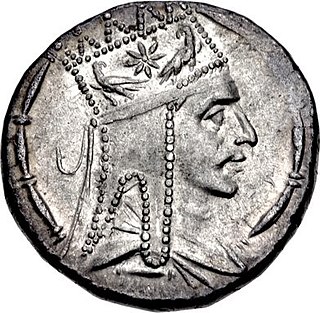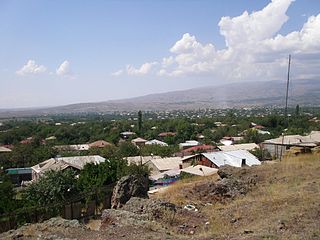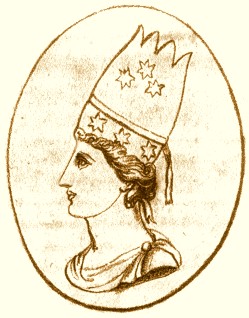Kingdom of Armenia may refer to:
- Kingdom of Armenia (antiquity), also known as Artaxiad or Arsacid Armenia, 380 BC to AD 387/428
- Bagratid Armenia, also known as the Kingdom of Armenia, AD 885 to 1045
Kingdom of Armenia may refer to:

Abgar V, called Ukkāmā, was the King of Osroene with his capital at Edessa.
Mithridates or Mithradates is the Hellenistic form of an Iranian theophoric name, meaning "given by Mithra". Its Modern Persian form is Mehrdad. It may refer to:

The history of Armenia covers the topics related to the history of the Republic of Armenia, as well as the Armenian people, the Armenian language, and the regions of Eurasia historically and geographically considered Armenian.

Caucasian Albania is a modern exonym for a former state located in ancient times in the Caucasus, mostly in what is now Azerbaijan. The modern endonyms for the area are Aghwank and Aluank, among the Udi people, who regard themselves as descended from the inhabitants of Caucasian Albania. However, its original endonym is unknown.
Armenia is a country in the South Caucasus region of Eurasia.

Armenians are an ethnic group and nation native to the Armenian highlands of West Asia. Armenians constitute the main population of Armenia and constituted the main population of the breakaway Republic of Artsakh until the 2023 Azerbaijani offensive in Nagorno-Karabakh and the subsequent flight of Nagorno-Karabakh Armenians. There is a wide-ranging diaspora of around five million people of full or partial Armenian ancestry living outside modern Armenia. The largest Armenian populations today exist in Russia, the United States, France, Georgia, Iran, Germany, Ukraine, Lebanon, Brazil, Argentina, Syria, and Turkey. The present-day Armenian diaspora was formed mainly as a result of the Armenian genocide with the exceptions of Iran, former Soviet states, and parts of the Levant.

Armenia, also the Kingdom of Greater Armenia, or simply Greater Armenia or Armenia Major sometimes referred to as the Armenian Empire, was a kingdom in the Ancient Near East which existed from 331 BC to 428 AD. Its history is divided into the successive reigns of three royal dynasties: Orontid, Artaxiad and Arsacid (52–428).

Gardman, also known as Gardmank' or Gardmanadzor, was one of the eight cantons of the ancient province of Utik' in the Kingdom of Armenia and simultaneously, together with the canton of Tuch'katak, an Armenian principality. It roughly corresponded within the Gazakh, Shamkir, Aghstafa, Dashkasan, Goygol, Tovuz, Gadabay districts of modern-day Azerbaijan and the original Tavush Region of Armenia. Gardman was also the name of the central fortress of the canton.
Lesser Armenia, also known as Armenia Minor and Armenia Inferior, comprised the Armenian-populated regions primarily to the west and northwest of the ancient Kingdom of Armenia, on the western side of the Euphrates River. It was also a kingdom, separate from Greater Armenia, from the 2nd century BC to the 1st century AD. The region was later reorganized into the Armeniac Theme under the Byzantine Empire.
Orodes is a male given name.

Oshakan is a village in the Ashtarak Municipality of the Aragatsotn Province of Armenia located 3 kilometers southwest from Ashtarak. It is well known to historians and pilgrims of the Armenian Apostolic Church as the site of the grave of Mesrop Mashtots, the inventor of the Armenian alphabet.

The Monastery of Saint Thaddeus The "Holy Tadeosi Cathedral " is an ancient Armenian monastery in the mountainous area of West Iran, in Iranian West Azerbaijan. It is believed to be one of the oldest church buildings in the world.

Erato was a queen of Armenia from the Artaxiad dynasty. She co-ruled as Roman client queen in 8–5 BC and 2 BC–AD 1 with Tigranes IV. Erato reigned alone in 1–2 AD. After living in political exile for a number of years, she co-ruled as Roman client queen from 6 until 12 with Tigranes V, her distant paternal relative and possible second husband. She may be viewed as one of the last hereditary rulers of her nation.
The origin of the Armenians is a topic concerned with the emergence of the Armenian people and the country called Armenia. The earliest universally accepted reference to the people and the country dates back to the 6th century BC Behistun Inscription, followed by several Greek fragments and books. The earliest known reference to a geopolitical entity where Armenians originated from is dated to the 13th century BC as Uruatri in Old Assyrian. Historians and Armenologists have speculated about the earlier origin of the Armenian people, but no consensus has been achieved as of yet. Genetic studies show that Armenian people are indigenous to historical Armenia, showing little to no signs of admixture since around the 13th century BC.
John is a common English name and surname:
Saint Hakob of Akori Monastery, was an Armenian monastery located in the southeastern part of the historic region of Surmali. The monastery was located 4.7 kilometers southwest of Akori, a village at the northeastern slope of Mount Ararat. Destroyed by an earthquake and avalanche in 1840, Akori was later rebuilt. It is known today as Yenidoğan and remains a small Kurdish village.
Bagratuni may refer to:
Arshak is a Persian and Armenian given name.

Ravished Armenia, also known as Auction of Souls, is a 1919 American silent film based on the autobiographical book Ravished Armenia by Arshaluys (Aurora) Mardiganian, who also played the lead role in the film. The film, which depicts the 1915 Armenian genocide by the Ottoman Empire from the point of view of Armenian survivor Mardiganian, who plays herself in the film, survives in an incomplete form.
Artsakh may refer to: